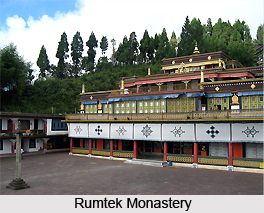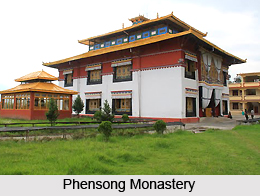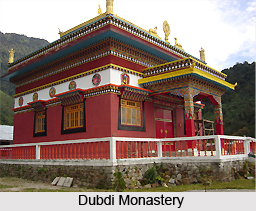 Unspoiled nature has rendered a unique spirituality to the place. This is the reason why the place is dotted with Buddhist monasteries. Religion leads to introspection and peace and the tranquility of Sikkim suits the purpose.
Unspoiled nature has rendered a unique spirituality to the place. This is the reason why the place is dotted with Buddhist monasteries. Religion leads to introspection and peace and the tranquility of Sikkim suits the purpose.
In East Sikkim the travelers will come across the Rumtek Monastery. It is accessible from Gangtok and is part of the Seven Point Tour of the city. The monastery was founded in15th century and belongs to the Yellow Hat Karrnapa Sect, a reformist branch of Tantric Buddhism. The monastery, built in the 1960s, is a replica of one in Tibet destroyed at the time of the Chinese takeover.
Do-Drul Chorten is another important tourist attraction in Gangtok. The capital city is scattered with pilgrimage centers belonging to both the Buddhists and the Hindus. In 1945 it was built by Truslshi Rimpoche, head of the Nyingma order of Tibetan Buddhism. What will grab the attention of the travelers are the 108 Mani Lakhangs or the prayer wheels. These are turned by the devoted Buddhists monks to invoke the Bodhisattva.
Hanuman Tok is famed for its Hindu temple.
Further west lies Pemayangtse. It houses a Red Hat Ningma Monastery, which the original sect built in 1705. Its walls and ceilings bear frescos of gods and demons. A one-day trek leads to Tashiding Ningma Monastery in the north. It was built in the year 1706. In case the tourists are interested in trekking then from Pemayangtse they can approach Kanchenjunga. As the altitude rises to 10,000 ft, then 14,000 ft the terraced rice-paddies and barley fields give way to apple-orchards, then fir trees, and mountain lakes.
 There are several hermitages in Sikkim and these are referred to as Tak-phu. Amongst these 4 hermitages are of great importance. These include Lha-ri nying phu. This rock cave is situated near Tashiding, West Sikkim. Kah-do Sang phu or "The Cave of the Occult Fairies" is located near Jorethang-Gyalshing highway. It is at a walking distance if one takes the pedestrian bamboo bridge from the highway.
There are several hermitages in Sikkim and these are referred to as Tak-phu. Amongst these 4 hermitages are of great importance. These include Lha-ri nying phu. This rock cave is situated near Tashiding, West Sikkim. Kah-do Sang phu or "The Cave of the Occult Fairies" is located near Jorethang-Gyalshing highway. It is at a walking distance if one takes the pedestrian bamboo bridge from the highway.
Pe-phu is nestlede between Tendong and Maenam hills in South Sikkim. It lies near Sangmoo Gumpa en route to Singtam. A huge cavern, believed to extend by a bifurcation to both Tendong and Maenam hill, visitors can still walk in about a quarter of a mile. As low as five feet at places, the cave opens up to a towering 100 feet at some sections.
The other pilgrimage centers in Sikkim are as follows:-
De-chhen phu is located near Rimbi, West Sikkim.
Enchey Monastery lies near Gangtok
Phensong Monastery, Kabi - Phodong in North Sikkim
Phodong Monastery, near Gangtok (38 kilometers)
Labrang Monastery, North Sikkim (40 kilometers from Gangtok)
Sa-Ngor-Chotshog Centre, Gangtok (5 kilometers)
Tashiding Monastery, Gyalshing (40 kilometers)
Pal Zurmang Kagyud Monastery or Lingdum Monastery, Gangtok (45 minutes drive)
Tsuk-La-Khang Monastery, Gangtok
Sanga Choeling Monastery, Pemayangtse (7 kilometers)
Dubdi Monastery, Yuksam
Kewzing Monastery, near Kewzing
Simik Monastery, near Singtam town
Hee Gyathang Monastery
 Lingthem Monastery
Lingthem Monastery
Khecheopalri Monastery, near Yuksom
Melli Monastery, near Yuksom
Sinon Monastery, Tashiding (20 kilometers)
Dalling Monastery, near Kewzing in South Sikkim
Yangyang Monastery, Rabangla (10 kilometers)
Namchi Monastery, Namchi
Chawayng Ani Monastery, near Phensang
Taktse Ogyen Choekhorling Monastery, north of Gangtok
Rhenock Monastery, Gangtok (63 kilometers)
Karthok Monastery, Gangtok (32 kilometers)
Sang Monastery, Sang village, near Rumtek
Ralang Monastery, Ravangla in South Sikkim
The centers for worship in Sikkim stand out from the rest of the sub-continent. It is one of the rare places that hugely reflect the impact of Buddhism.






